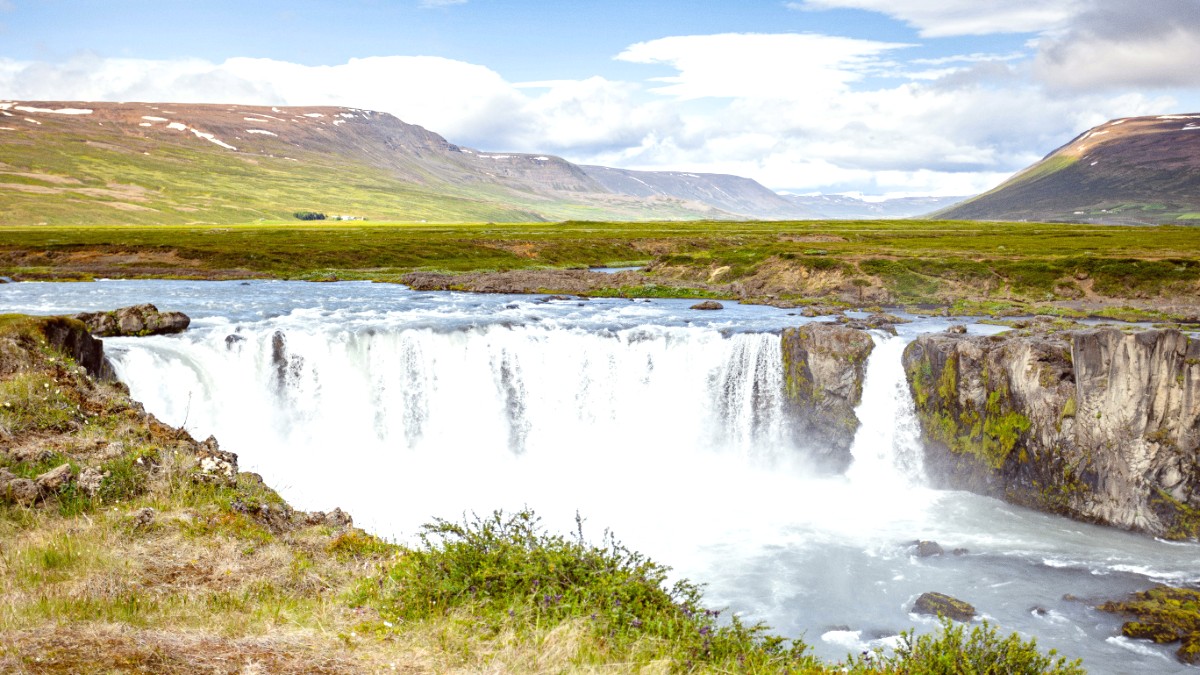
The North, Iceland
These must-visit sites define Akureyri and its immediate region.
Most natural attractions around Akureyri, like Goðafoss and the Mývatn area, are open 24/7 and free to access. Museums and specific attractions have varied hours and entrance fees; confirm these on their websites or at the Akureyri Tourist Information Center. Guided tours to these sites are available from numerous local operators, including those on GetYourGuide.
Akureyri offers a range of museums and cultural venues that explore local history, art, and heritage.
Just south of the city center, this area presents some of Akureyri's oldest buildings and charming wooden houses, displaying picturesque historical architecture.
A significant historical and architectural landmark, prominently positioned over the city. Its modernist design reflects the architectural trends of its time.
Explore these areas to connect with the city's heritage and past, viewing how it evolved over centuries.
Many of these sites are easily accessible for a self-guided walking tour, allowing for a leisurely pace of exploration.
The historical areas radiate an unique local charm, with their well-preserved buildings and quiet streets inviting exploration.
North Iceland boasts dramatic and diverse natural landscapes, with Akureyri serving as a gateway.
One of Iceland's most famous and beautiful waterfalls, located about a 30-minute drive east of Akureyri on the Ring Road. It is easily accessible and visually stunning.
Lystigarður Akureyrar (Botanical Garden) is a peaceful oasis. Vaglaskógur and Kjarnaskógur are rare forested areas with hiking trails.
Akureyri is a prime location for whale watching. Humpback whales, minke whales, and white-beaked dolphins are commonly seen in Eyjafjörður. Tours depart directly from the harbor. Consider booking via GetYourGuide.
A region of unique geological formations, pseudocraters, hot springs, and diverse birdlife, approximately an hour's drive east of Akureyri. Highlights include Dimmuborgir and Hverir.
Dettifoss, Europe's most powerful waterfall, lies further east. Aldeyjarfoss, a beautiful basalt column waterfall, offers a more secluded experience (4x4 often needed).
Lake Mývatn is a renowned birdwatching destination. Puffin colonies are on nearby islands like Hrísey or Grímsey during nesting season (May to mid-August).
Explore Hverir with its bubbling mud pots and fumeroles near Mývatn, or Dimmuborgir's impressive lava formations and walking trails. Grjótagjá offers a small lava cave with a geothermal spring.
Lake Mývatn is known for its pseudocraters and diverse birdlife. Eyjafjörður offers opportunities for boat tours and a dramatic aquatic landscape. Akureyri also has a small, quiet black sand beach.
Visit Goðafoss early or late to avoid crowds. Head to dark spots outside city lights, like Hlíðarfjall, for optimal Northern Lights viewing. Explore smaller roads along Eyjafjörður for various stunning viewpoints.
Beyond the popular spots, Akureyri holds lesser-known treasures that offer unique experiences.
Discover what locals enjoy and where to capture unforgettable images.
Akureyri also boasts emerging destinations like the Arctic Coast Way, a new official tourist route along the northern coast. It offers a slower, more immersive way to explore Iceland's less-traveled areas.
Experience Akureyri like a local by visiting these popular spots.
Capture distinctive images that reflect Akureyri's charm.
Efficient travel options for exploring Akureyri and its surroundings.
Information for visitors with varying accessibility needs.
Summer offers long daylight hours for extensive exploration of natural attractions and outdoor activities. Winter provides opportunities for Northern Lights and skiing.
Offline maps and GPS apps are valuable, especially in remote areas with limited phone signal. Tourist information centers also offer maps and advice.
Icelandic weather changes rapidly. Dress in layers and pack waterproof and windproof outer shells, regardless of the season, for comfort and safety during sightseeing.
Stick to marked trails, do not drive off-road, and take all trash with you. Iceland's fragile ecosystems need protection.
Patronize local businesses, restaurants, and tour operators. Your financial contributions strengthen the community.
Conserve water and energy where possible. Choose eco-friendly accommodation options when available.
Be mindful of local customs and traditions. A little research into Icelandic culture enhances your visit.
Check road conditions and weather forecasts regularly, especially when driving to remote natural attractions.
Capture memories responsibly and respectfully.
Rely on local knowledge for an enriching and safe experience.
Always prioritize safety. Check weather forecasts and road conditions before heading out, especially to remote areas or during winter.
Inform someone of your travel plans if venturing into isolated regions.
Maximize your sightseeing time with these planning considerations.
Allocate sufficient time for travel between attractions, especially when venturing outside Akureyri.
Factor in entrance fees, transportation costs, and any guided tour expenses.
Integrate picturesque drives into your itinerary for a fuller experience of the region.
Always check road conditions, especially for gravel or F-roads.
Consider organized tours for specific attractions or full-day excursions.
Many tours originate directly from Akureyri's city center or harbor.
Proper planning for clothing and supplies makes for a comfortable trip.
Good hiking boots are a must for exploring natural sites.
Build flexibility into your schedule to accommodate rapid weather changes, allowing for spontaneous adjustments to your plans.
Summer offers near 24-hour light, while winter features very short days for sightseeing but longer nights for aurora hunting.
Avoid over-scheduling. Allow ample time to enjoy each site without rushing. Iceland's beauty merits unhurried appreciation.